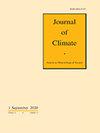Future Changes of Extreme Precipitation and Related Atmospheric Conditions in East Asia under Global Warming Projected in Large Ensemble Climate Prediction Data
IF 4
2区 地球科学
Q1 METEOROLOGY & ATMOSPHERIC SCIENCES
引用次数: 0
Abstract
Abstract Extreme precipitation is expected to pose a more severe threat to human society in the future. This work assessed the historical performance and future changes of extreme precipitation and related atmospheric conditions in a large ensemble climate prediction dataset, the database for Policy Decision-making for Future climate change (d4PDF), over East Asia. Compared with the TRMM and ERA5 datasets, the historical climate in d4PDF represents favorably the precipitation characteristics and the atmospheric conditions, although some differences are notable in the moisture, vertical motion, and cloud water fields. The future climate projection indicates that both the frequency and intensity of heavy precipitation events over East Asia increase compared with those in the present climate. However, when comparing the atmospheric conditions in the historical and future climates for the same precipitation intensity range, the future climate indicates smaller relatively humidity, weaker ascent, less cloud water content, and smaller temperature lapse rate, which negatively affect generating extreme precipitation events. The comparison of the precipitation intensity at the same amount of precipitable water between the historical and future climates indicates that extreme precipitation is weaker in the future, because of the more stabilized troposphere in the future. The general increase in extreme precipitation under future climate is primarily due to the enhanced increase in precipitable water in the higher temperature ranges, which counteracts the negative conditions of the stabilized troposphere.大型集合气候预测数据预测全球变暖下东亚极端降水及相关大气条件的未来变化
摘要 极端降水预计将在未来对人类社会构成更严重的威胁。这项工作评估了东亚地区大型集合气候预测数据集--未来气候变化决策数据库(d4PDF)中极端降水及相关大气条件的历史表现和未来变化。与 TRMM 和 ERA5 数据集相比,d4PDF 中的历史气候较好地反映了降水特征和大气条件,但在水汽、垂直运动和云水场方面存在明显差异。未来气候预测表明,东亚地区强降水事件的频率和强度都比现在的气候有所增加。然而,在相同降水强度范围内,比较历史气候和未来气候的大气条件,未来气候表明相对湿度较小、上升力较弱、云水含量较少、温度失效率较小,这些都对极端降水事件的产生产生不利影响。通过比较历史气候和未来气候在相同可降水量下的降水强度,可以看出未来极端降水较弱,这是因为未来对流层更加稳定。未来气候下极端降水的普遍增加主要是由于较高温度范围内可降水量的增加,这抵消了对流层稳定的不利条件。
本文章由计算机程序翻译,如有差异,请以英文原文为准。
求助全文
约1分钟内获得全文
求助全文
来源期刊

Journal of Climate
地学-气象与大气科学
CiteScore
9.30
自引率
14.30%
发文量
490
审稿时长
7.5 months
期刊介绍:
The Journal of Climate (JCLI) (ISSN: 0894-8755; eISSN: 1520-0442) publishes research that advances basic understanding of the dynamics and physics of the climate system on large spatial scales, including variability of the atmosphere, oceans, land surface, and cryosphere; past, present, and projected future changes in the climate system; and climate simulation and prediction.
 求助内容:
求助内容: 应助结果提醒方式:
应助结果提醒方式:


